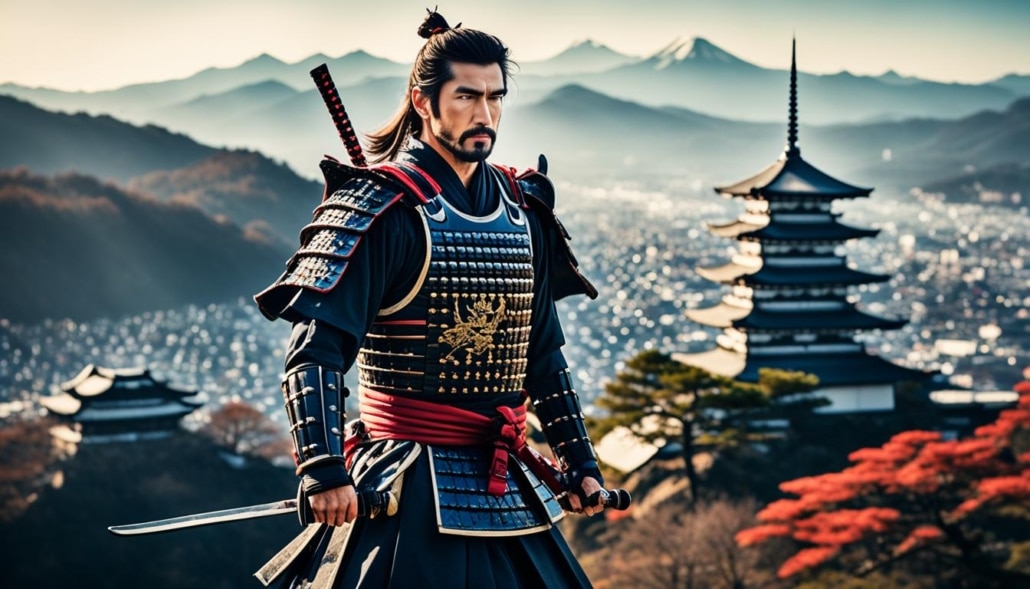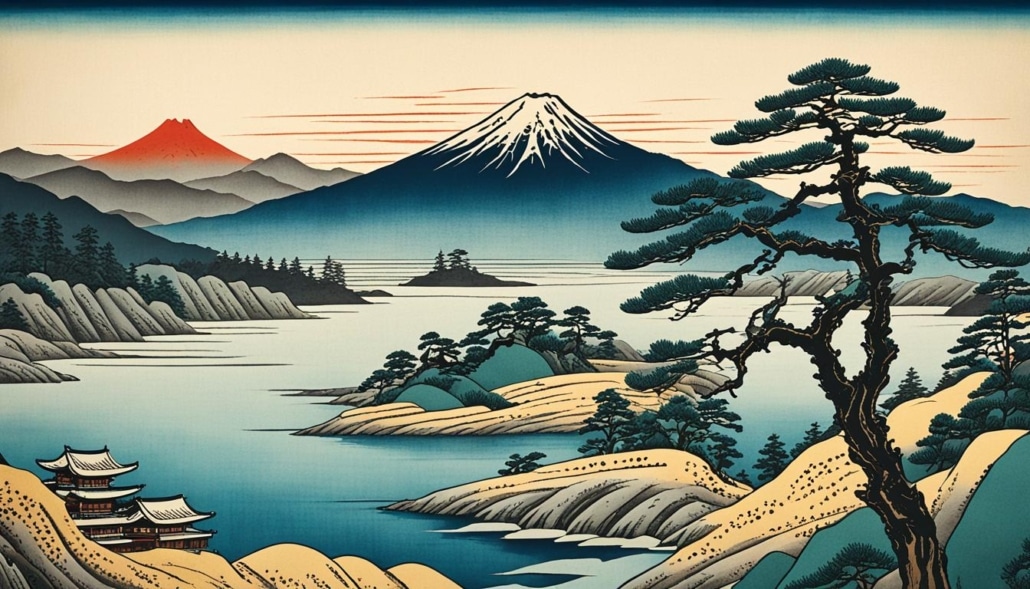Japan, a nation steeped in history and tradition, offers a fascinating journey through time and culture. From its ancient shrines and temples to the modern metropolis, Japan’s cultural heritage is both profound and enchanting. In this article, we explore the multifaceted aspects of Japanese culture, delving deep into its history, arts, festivals, and culinary traditions to provide a comprehensive guide that captures the essence of this remarkable country.
Key Takeaways:
- Immerse yourself in Japan’s rich cultural heritage through its traditional arts, spiritual traditions, and historical sites.
- Experience the deep-rooted traditions of Shintoism and Buddhism, visiting iconic shrines and temples.
- Discover the code of bushido and the world of the samurai, exploring the martial arts and tea ceremonies.
- Appreciate Japan’s artistic expressions, from the historic ukiyo-e prints to the modern world of manga and anime.
- Indulge in the delights of Japanese cuisine, savoring the flavors of sushi, ramen, and matcha.
Historical Roots: The Foundation of Japanese Culture
Japan’s history is a rich tapestry woven with tales of emperors, samurai, and shoguns. The Nara and Heian periods marked the blossoming of Japanese culture, with the creation of iconic literature such as “The Tale of Genji.” The Kamakura and Muromachi periods saw the rise of the samurai and the establishment of the shogunate, while the Edo period brought about a time of peace and cultural flourish. Understanding these historical epochs is crucial to appreciating the depth and complexity of Japan’s cultural landscape.
The Nara period (710-794) and Heian period (794-1185) were pivotal eras in shaping Japan’s cultural identity. During the Nara period, significant developments in governance, Buddhism, and literature took place. It was in this period that the capital was moved to Nara, and the first permanent imperial residence, the Heijo-kyo, was constructed. The Heian period was characterized by a refined aristocratic culture, the flourishing of Japanese literature, and the establishment of the imperial court in Kyoto.
Spiritual Traditions: Shintoism and Buddhism
At the heart of Japan’s cultural heritage lies its spiritual traditions. Shintoism, the indigenous faith of Japan, celebrates the sacredness of nature and the existence of kami (gods or spirits) in everything. The grand shrines of Ise and the serene torii gates of Miyajima are testaments to Shinto’s enduring legacy. Buddhism, introduced from China and Korea, brought with it a profound philosophical influence, exemplified by the majestic temples of Kyoto and the tranquil Zen gardens found throughout the country.
Shintoism, deeply rooted in Japanese history, is a syncretic blend of animism, shamanism, and reverence for ancestral spirits. It emphasizes the interconnection between humans and the natural world, with kami regarded as divine forces inhabiting trees, rocks, and rivers.
Shinto Shrines and Torii Gates
The Japanese archipelago is adorned with countless shrines and torii gates, standing as ethereal gateways between the human and divine realms. Among the most venerated is the Ise Grand Shrine, dedicated to Amaterasu Omikami, the sun goddess and progenitor of the imperial family. Its sacred architecture represents the essence of Shinto design, harmonizing with the surrounding nature.
Another iconic symbol of Shintoism is the torii gate. The vermilion torii gates of Miyajima Island, located near Hiroshima, offer a mesmerizing sight during high tide, seemingly floating on the water. This spiritual destination encapsulates the serenity and unity of Shinto belief.
Buddhism: The Path of Enlightenment
Buddhism arrived in Japan during the 6th century, flourishing alongside Shintoism and leaving an indelible mark on the country’s cultural landscape. As a philosophy and spiritual practice, Buddhism focuses on the attainment of enlightenment and the ultimate liberation from suffering.
Kyoto, once the imperial capital, emerged as a center of Buddhist devotion and scholarship. It is here that some of Japan’s most revered temples can be found, each showcasing distinctive architectural styles and offering introspective spaces for meditation and contemplation.
| Temple | Highlight |
|---|---|
| Kinkaku-ji (Golden Pavilion) | A stunning Zen temple adorned with gold leaf |
| Kiyomizu-dera | A UNESCO World Heritage Site known for its wooden terrace and panoramic views of Kyoto |
| Ryoan-ji | Home to a famous rock garden, inviting contemplation and serenity |
These temples offer a glimpse into the intricate fusion of Buddhist teachings, artistic expression, and architectural mastery. Visitors can explore the rich symbolism within each temple, engage in Zen meditation, or participate in traditional tea ceremonies – a harmonious blend of Buddhism and the way of tea.
“In Buddhism, one seeks to awaken the mind and attain enlightenment. It is a journey of self-discovery and liberation from the cycle of suffering.”
From the tranquil moss gardens of Saihō-ji temple to the vibrant autumn foliage framing Tenryū-ji temple, Kyoto serves as a sanctuary for spiritual exploration and introspection.
The Way of the Warrior: Bushido and the Samurai
The samurai, Japan’s legendary warriors, lived by the code of bushido, which emphasized honor, discipline, and loyalty. This warrior ethos deeply influenced Japanese culture, from the martial arts of kendo and judo to the way of tea, a ceremonial practice embodying harmony and respect. Exploring the castles, armor, and weaponry of the samurai offers a glimpse into a pivotal aspect of Japan’s cultural identity.
Rooted in feudal Japan, the samurai class emerged in the 12th century and played a significant role in shaping the nation’s history. They were not merely skilled fighters but also exemplifiers of a strict moral code known as bushido, meaning “the way of the warrior.” This code was a guiding principle for samurai behavior, emphasizing virtues such as loyalty, righteousness, and courage.
Samurai training encompassed various forms of martial arts, which went beyond physical combat and focused on spiritual and mental discipline. The practice of kendo, known as the way of the sword, aimed to cultivate not just technical swordsmanship but also ethics and personal development. Judo, another martial art derived from jujitsu, emphasized throwing and grappling techniques. These martial arts not only developed warriors but also shaped their character and mindset.
The samurai’s commitment to discipline extended beyond the battlefield. Their dedication to cultivating inner harmony and mindfulness is exemplified in the way of tea, or chanoyu. This ceremonial practice revolves around the preparation and serving of powdered green tea, known as matcha. The tea ceremony embodies principles of purity, tranquility, and respect, with each movement and gesture carefully choreographed to create an atmosphere of harmony and mindfulness.
“In the way of the samurai, every action has meaning, every moment is an opportunity to live according to the principles of bushido.”
Exploring the legacy of the samurai allows us to delve into Japan’s cultural heritage and gain insight into the values that have shaped the nation’s identity. Visiting historical landmarks such as castles provides a glimpse into the world of the samurai, where honor and duty were paramount. The intricate armor and weaponry on display showcase the craftsmanship and artistry that went into creating tools of war.
The samurai may belong to a bygone era, but their legacy lives on in the values that continue to shape Japanese society. The influence of bushido can be seen not only in the martial arts but also in the unwavering commitment to honor, the pursuit of excellence, and respect for one’s adversaries.
Artistic Expressions: From Ukiyo-e to Modern Manga
Japanese art is a testament to the timeless beauty and intricate craftsmanship that defines the country’s cultural heritage. From the delicate brush strokes of calligraphy to the vibrant colors of ukiyo-e prints, the artistic traditions of Japan have captivated the world for centuries.
Ukiyo-e, meaning “pictures of the floating world,” emerged during the Edo period (1603-1868) and became a popular form of art. These woodblock prints depicted scenes from everyday life, kabuki theater, and landscapes, allowing the viewer to experience the ephemeral world of pleasure, entertainment, and inner emotions. The influence of ukiyo-e extended far beyond Japan, inspiring renowned Western artists like Vincent van Gogh and Claude Monet.
Calligraphy, known as shodo, is not just a form of writing but is considered one of the highest art forms in Japan. The meticulous strokes and balance of characters are deeply rooted in the principles of Zen Buddhism and reflect the artist’s state of mind. The elegance of calligraphy can be seen in various contexts, including religious scriptures, poetry, and even everyday items like shop signs and restaurant menus.
Another traditional art form that continues to thrive is ikebana, the art of flower arrangement. This centuries-old practice involves mindful placement of flowers and other natural elements to create harmonious and balanced compositions. Ikebana reflects the appreciation for nature’s fleeting beauty and embodies the philosophy of wabi-sabi, finding beauty in imperfection and transience.
Pottery, with its rich history dating back over 10,000 years, is yet another artistic expression deeply ingrained in Japanese culture. From the rustic beauty of traditional raku ware to the delicate and refined aesthetics of porcelain, Japanese ceramics showcase the craftsmanship and attention to detail for which the country is renowned.
While traditional art forms have laid the foundation for Japan’s artistic identity, modern art forms such as manga and anime have gained global recognition for their creativity and storytelling. Manga, which refers to Japanese comic books and graphic novels, covers a wide range of genres, from fantasy and science fiction to romance and historical dramas. The distinctive art style and dynamic narratives have made manga a significant cultural export, captivating readers of all ages around the world.
Similarly, anime, the animated counterpart to manga, has revolutionized the entertainment industry. From classic anime series like “Astro Boy” to internationally acclaimed films like Hayao Miyazaki’s “Spirited Away,” anime has garnered a dedicated fan base and continues to push the boundaries of visual storytelling.
Through these diverse artistic expressions, Japan has established itself as a cultural powerhouse, constantly inspiring and influencing global creative trends.
Culinary Journey: The Delicacies of Japanese Cuisine
Japanese cuisine, or washoku, is a UNESCO Intangible Cultural Heritage, celebrated for its emphasis on seasonal ingredients, balance, and presentation. From the artistry of sushi and the comfort of a steaming bowl of ramen to the ceremonial preparation of matcha, Japanese food is an integral part of the cultural experience. Exploring the diverse regional dishes and sake breweries offers a delicious insight into Japan’s culinary heritage.
The heart and soul of Japanese cuisine lies in its attention to detail and reverence for nature. With its focus on fresh, locally sourced ingredients, washoku showcases the natural flavors of each seasonal component. Every dish is carefully crafted to achieve a harmonious balance of taste, texture, and visual appeal.
Signature Japanese Delicacies
Let’s explore some of the iconic dishes that have captivated food enthusiasts around the world:
- Sushi: This famous Japanese dish combines vinegared rice with various toppings, including fresh seafood, vegetables, and pickled ingredients. Sushi is meticulously prepared, with each piece showcasing the chef’s skill and creativity.
- Ramen: A steaming bowl of ramen, with its flavorful broth, perfectly cooked noodles, and a variety of toppings, is the ultimate comfort food in Japan. Regional variations, such as the rich tonkotsu ramen of Fukuoka or the soy-based shoyu ramen of Tokyo, offer a diverse range of flavors.
- Tempura: Tempura is a dish of lightly battered and deep-fried seafood, vegetables, and mushrooms. The result is a crispy coating that encapsulates tender, flavorful ingredients. Tempura is typically served with a dipping sauce and enjoyed in specialized restaurants or traditional Japanese teahouses.
A Culinary Melting Pot
Japanese cuisine draws inspiration from both its indigenous roots and cultural influences from around the world. Historical connections with China and Korea introduced ingredients like soy sauce, tofu, and noodles, which eventually became integral components of Japanese dishes.
Furthermore, Japan’s distinct regional cuisines reflect the country’s diverse geography and climate. From the seafood-rich dishes of coastal regions like Hokkaido to the hearty, soy-based flavors of the Kansai region, each area boasts its unique culinary traditions and specialties.
The Art of Tea
No exploration of Japanese cuisine is complete without mentioning matcha, a finely ground powdered green tea that holds a special place in Japanese culture. Matcha is not only enjoyed as a refreshing beverage but is also used in traditional tea ceremonies, where precise techniques and rituals are observed to prepare and serve the tea.
The meditative practice of the tea ceremony embodies harmony, respect, and tranquility, allowing participants to immerse themselves in the present moment and appreciate the beauty of simplicity.
A Taste of Japan’s Culinary Heritage
To truly experience the depth and richness of Japanese cuisine, one must sample the regional specialties and local delicacies that each area has to offer. Here are a few examples of regional dishes that showcase Japan’s culinary diversity:
| Region | Specialty Dish |
|---|---|
| Kyoto | Kaiseki Ryori: A multi-course meal featuring meticulously prepared small dishes that showcase seasonal ingredients. |
| Hiroshima | Okonomiyaki: A savory pancake made with cabbage, noodles, and various toppings, cooked on a hot griddle. |
| Nagano | Soba: Thin buckwheat noodles typically served cold with a dipping sauce or in a hot broth. |
| Fukuoka | Hakata Tonkotsu Ramen: A pork-based ramen with thin noodles and toppings like sliced pork, green onions, and pickled ginger. |
Japan’s culinary journey offers a feast for the senses, allowing visitors to savor the flavors, traditions, and stories that have shaped this remarkable cuisine. Whether you’re indulging in a bowl of ramen from a street vendor or dining in an elegant sushi restaurant, every bite is an opportunity to connect with the rich cultural heritage of washoku.
The Path Forward: Preserving and Innovating
As Japan looks to the future, it recognizes the importance of preserving its cultural heritage while embracing innovation and change. With a deep commitment to cultural preservation, the country has undertaken various initiatives to safeguard traditional crafts, restore historical sites, and promote cultural tourism. By doing so, Japan ensures that its rich heritage will continue to be celebrated and shared with the world.
At the same time, Japan is not simply bound by tradition. The country’s ongoing contributions to technology, fashion, and pop culture keep its cultural landscape vibrant and evolving. With advancements in technology, Japan has managed to blend its traditional practices with modern innovations, creating a unique juxtaposition of the past and the present. From interactive museum exhibits to digital art installations, technology has become an integral part of cultural experiences in Japan.
Moreover, Japan’s pop culture, including anime and manga, has captured the hearts of people around the globe. These forms of artistic expression have not only become a significant part of Japan’s modern identity but have also influenced popular culture worldwide. The global reach of Japanese pop culture has been instrumental in preserving and spreading awareness of traditional customs and practices. It has sparked interest in traditional arts, festivals, and historical landmarks.
| Cultural Preservation | Technology | Pop Culture | |
|---|---|---|---|
| Initiatives | Efforts to safeguard traditional crafts, restore historical sites, and promote cultural tourism | Integration of technology in cultural experiences, preservation of heritage through digital platforms | Exportation of Japanese pop culture, raising global awareness of Japanese traditions |
| Influence | Promotes the appreciation and continuation of traditional practices | Enables innovative ways to engage with cultural heritage | Preserves and promotes traditional customs through modern mediums |
| Benefit | Ensures the longevity of Japan’s rich heritage | Enhances visitor experiences and accessibility to cultural attractions | Sparks curiosity and appreciation for Japanese traditions, attracting visitors worldwide |
By striking a balance between the preservation of its cultural roots and embracing new forms of expression, Japan paves the way for a future that both respects tradition and encourages creativity. This harmonious blend of preservation and innovation ensures that Japan’s cultural heritage remains relevant and cherished for generations to come.
Conclusion
In conclusion, Japan’s cultural heritage encompasses a rich tapestry of history, spirituality, art, and tradition. Through the exploration of its ancient roots and contemporary expressions, travelers can embark on a transformative journey that offers deep insights into the essence of Japanese culture.
From the majestic shrines and temples that stand as testaments to centuries of spiritual devotion to the traditional arts and culinary delights that tantalize the senses, Japan offers a multitude of cultural experiences that capture the imagination and leave a lasting impact.
Preservation of heritage remains a top priority in Japan, with ongoing efforts to safeguard historical sites, promote traditional crafts, and foster cultural tourism. This commitment ensures that both the tangible and intangible aspects of Japan’s cultural legacy are cherished and passed on to future generations.
For those seeking a truly immersive experience, Japan travel offers an unparalleled opportunity to engage with a vibrant and evolving cultural landscape. Whether it’s exploring the ancient samurai history, indulging in the world-renowned sushi and ramen, or admiring the intricate beauty of ukiyo-e prints, Japan’s cultural richness promises to captivate and inspire.
FAQ
What are some significant historical periods in Japanese culture?
Some significant historical periods in Japanese culture include the Nara and Heian periods, the Kamakura and Muromachi periods, and the Edo period.
What are the main spiritual traditions in Japan?
The main spiritual traditions in Japan are Shintoism and Buddhism.
What is the significance of shrines and temples in Japanese culture?
Shrines and temples play a vital role in Japanese culture, serving as places of worship and reflecting the deep spiritual beliefs of Shintoism and Buddhism.
How did the samurai influence Japanese culture?
The samurai, with their code of bushido, greatly influenced Japanese culture, contributing to the development of martial arts, such as kendo and judo, and practices like the tea ceremony.
What are some traditional art forms in Japan?
Some traditional art forms in Japan include ukiyo-e woodblock prints, calligraphy, and pottery.
How has Japanese cuisine become globally recognized?
Japanese cuisine, known as washoku, has gained global recognition for its emphasis on seasonal ingredients, balance, and presentation, with dishes like sushi, ramen, and matcha becoming popular worldwide.
How does Japan balance cultural preservation with innovation?
Japan actively works to preserve its cultural heritage through initiatives that safeguard traditional crafts and historical sites while embracing technological advancements and contributing to pop culture trends.



















